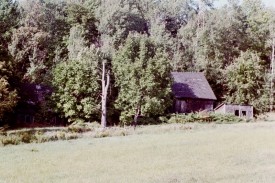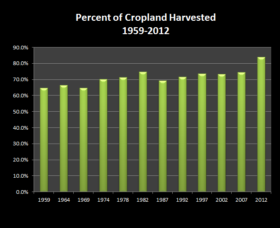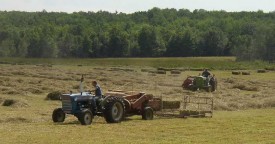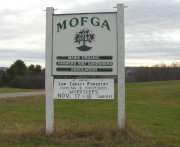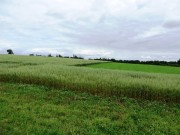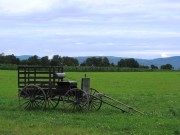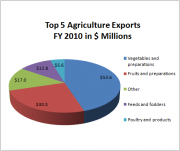-
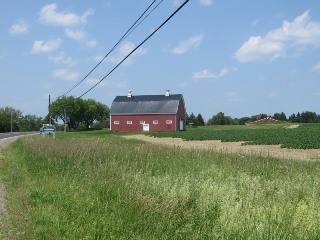
sign: “Welcome to Washburn” with Red Barn -

Potato Field off Route 164 in Washburn
As Maine communities began to lose some of their frontier aspects in the early 19th century and assumed a more settled appearance, civic improvements were initiated. Among these was the regulation of livestock which, in contrast to earlier times, were becoming numerous. Swine, although useful for consuming garbage, in themselves provided a health hazard. No longer were they to be given full run of the community but were required to be confined. Horses, cattle, and sheep had traditionally been confined to pasture, but not too carefully. As their numbers increased, stray animals became a nuisance. As a result pounds, or public enclosures, were established in many communities where animals could be confined until redeemed by their owners for a small fine. With the increase of more scientific agricultural practices, these pounds became obsolete. Some have survived, most built of stone. See examples at Brooklin, Harpswell Center, Jefferson, Orrington, Pownal, Waldoboro, or search cattle pounds.
See what’s in season from the Maine Agriculture Bureau.
While potatoes are still the dominant crop, the number of all farms in Maine is now about one-sixth that of the 1930’s and the number of cropland acres is just over one-third the earlier period. Interestingly, the difficult times of the Great Depression (1935) and World War II (1945) drew increases in the number of farms and the number of farm acres. Beginning in 1950, the long-term modern decline in farms and acreage had begun, continuing through the end of the century.
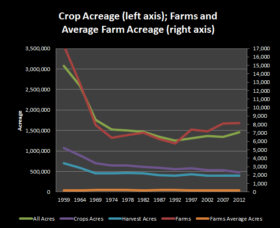 Dropping precipitously (red line in the graph at left), since 1959 the number of farms has declined but it has recovered somewhat in the last two decades, as has the total farm acreage (green line). Even with fewer and smaller farms, the crop and harvested acreage has stabilized. [click graphs to enlarge]
Dropping precipitously (red line in the graph at left), since 1959 the number of farms has declined but it has recovered somewhat in the last two decades, as has the total farm acreage (green line). Even with fewer and smaller farms, the crop and harvested acreage has stabilized. [click graphs to enlarge]
In the 19th century, farming was so widespread that a substantial part of the forest was cleared throughout the state. Since the mid-twentieth century, the loss of farmland to other uses has included reforestation of former agricultural areas especially in northern Maine.
Traditional farm equipment drawn by horses or oxen, was gradually replaced by tractors and trucks. Stone walls that once defined pastures and property boundaries are now sometimes deeply embedded in the woods and abandoned farm houses mark once productive land.
During virtually the same period (1945-1992), the size of the average farm’s size doubled from 109 to 218 acres. In the 1940’s young people like Alice Whitten, a student at Deering High School in Portland, found summer employment on Maine’s farms. Here she checks in beans with Miss Corthell, Athletic Instructor, in this Federal Extension Service photo.
Since the 1940’s, the average size has declined but the number of farms has increased, possibly due to the efforts of the Maine Organic Farmers and Gardeners Association. The “back-to-the-land” movement of the 1970’s in Maine brought renewed interest in self-sufficient, organic farming. Helen and Scott Nearing were inspirations for many who sought “the good life.”
In the 21st century non-traditional approaches are being tested to see if small farms can be made sustainable. Here is one assessment of the problem in A Cooperative Approach to Local Economic Development:
Low farm prices in recent years have pressured many farm families to seek alternative ways to raise family incomes. New crops, identity-preserved products, and expanded domestic and foreign markets have all been tried in one way or another. In some cases, farm producers have earned a substantial premium for their products; in other cases, the premium was relatively short lived as other producers entered the market and drove the price down.
Farm groups realize that their share of the food dollar has dwindled. Consequently, substantial interest has been shown in farmer-owned companies that process farm products and market them to consumers.
Also in the 21st century, the number of Amish family farms has expanded substantially in southern Aroostook County and other locations. They are using the alternative technology of an earlier century for sustainable agriculture with crops other than potatoes: oats, corn and hay for the many horses.
|
Year |
#Farms | All Acres |
Crops Acres |
Harvest Acres |
Farm Ave. |
|
| 1930 | 39,006 | 4,639,938 | 119 | |||
| 1935 | 41,907 | 4,721,842 | 113 | |||
| 1940 | 38,980 | 4,223,297 | 108 | |||
| 1945 | 42,184 | 4,613,175 | 109 | |||
| 1950 | 30,558 | 4,181,613 | 137 | |||
| 1954 | 23,638 | 3,614,242 | 153 | |||
| 1959 | 17,360 | 3,081,987 | 1,077,670 | 698,188 | 178 | |
| 1964 | 12,875 | 2,590,022 | 894,206 | 594,434 | 201 | |
| 1969 | 7,971 | 1,759,700 | 706,769 | 457,935 | 221 | |
| 1974 | 6,436 | 1,523,696 | 641,940 | 449,901 | 237 | |
| 1978 | 6,775 | 1,500,390 | 650,356 | 463,029 | 221 | |
| 1982 | 7,003 | 1,468,674 | 610,691 | 457,076 | 210 | |
| 1987 | 6,269 | 1,342,588 | 592,309 | 410,891 | 214 | |
| 1992 | 5,776 | 1,258,297 | 559,424 | 399,755 | 218 | |
| 1997 | 7,404 | 1,313,066 | 580,260 | 426,711 | 177 | |
| 2002 | 7,196 | 1,369,768 | 536,839 | 394,121 | 190 | |
| 2007 | 8,136 | 1,347,566 | 529,253 | 393,738 | 166 | |
| 2012 | 8,173 | 1,454,104 | 477,343 | 400,960 | 178 | |
| The Agricultural Census is conducted every five years, with results reported one year after the census. See data on practices and economics. Except for number of farms, data above is expressed in acres. Data is not strictly comparable due to changes in the definition of farms by the U.S. Census. 1959-1992 data from http://www.agcensus.usda.gov/Publications/1992/Volume_1/Maine/me1_01.pdf. 1997, 2002, 2007 data from http://www.agcensus.usda.gov/Publications/2007/Full_Report/Volume_1,_Chapter_1_State_Level/ Mainest23_1_001_001.pdf. |
||||||
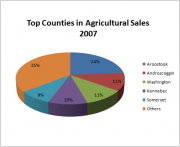 The agricultural sector has shrunk in financial terms as well. Gross farm income has declined more than production costs in the post-World War II era. A mitigating factor is the continued existence of associated activities, such as potato starch production for the processed food and other industries. In addition agricultural subsidies from the federal government have helpful to thousands of Maine farmers.
The agricultural sector has shrunk in financial terms as well. Gross farm income has declined more than production costs in the post-World War II era. A mitigating factor is the continued existence of associated activities, such as potato starch production for the processed food and other industries. In addition agricultural subsidies from the federal government have helpful to thousands of Maine farmers.
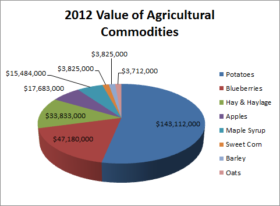 Despite a decline in the potato sector, Aroostook County was still the top county in agricultural sales in 2007, and potatoes was still the largest crop by value in 2009. Vegetables, including potatoes, accounted for more than half of the values of all agriculture exports from the state in 2010.
Despite a decline in the potato sector, Aroostook County was still the top county in agricultural sales in 2007, and potatoes was still the largest crop by value in 2009. Vegetables, including potatoes, accounted for more than half of the values of all agriculture exports from the state in 2010.
Though not strictly farming, blueberry growing has been a long-term agricultural pursuit in Maine. Primarily based Downeast in Washington and Hancock Counties, the industry continues to produce the prized Maine berries. The plant leaves turn their characteristic flaming red each fall. Strawberries are another of commercial fruits contributing to Maine’s agricultural economy. Another element of note is the maple sugar industry.
The University of Maine coordinates a system of agricultural experiment stations to test growing techniques and provide research for the state’s farmers. The Maine Organic Farmers and Gardeners Association (MOFGA) provides workshops for farmers and promotes organic practices through its annual Common Ground Fair, one of many agricultural fairs in Maine.
Additional Resources
United States Department of Agriculture, National Agricultural Statistics Service: various Statistical Bulletins and their Internet site at http://www.nass.usda.gov (accessed January, 2007).
2010 U.S. Statistical Abstract, Farms and Farmland at http://www.census.gov/compendia/statab/cats/agriculture/farms_and_farmland.html (accessed 9/27/2010)
U.S. Department of Agriculture. “2012 Census Volume 1, Chapter 1: State Level Data (Maine), Table 1.” https://www.agcensus.usda.gov/Publications/2012/Full_Report/Volume_1,_Chapter_1_State_Level/Maine/ (accessed December 31, 2016)
Castle, Robert C. Notebook, 1912-1916. (Cataloger note: “A notebook used by a farmer in Belgrade, Maine. The notebook was used between the years 1912 and 1916 to record farm products bought and sold, recipes, work done on his farm buildings, crops planted, and occasionally as a diary. Many of the records are about his poultry farm and the number of eggs that he sold.” [Orono. University of Maine. Raymond H. Fogler Library. Special Collections.]
Merrett, Christopher D. and Norman Walzer. A Cooperative Approach to Local Economic Development. Westport, Conn. Quorum Books. 2001.



